Top News
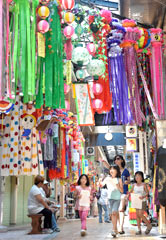
July 7, 2014 Ryukyu Shimpo
July 7 is Tanabata, a Japanese star festival. The day belongs to Shosho or “minor heat”, one of 24 solar terms in the traditional East Asian lunisolar calendars. According to the calendar, summer officially begins on this day.
The star festival was held at the first avenue of the Chuo district in Okinawa City. The participants wrote wishes on tanzaku, small pieces of paper, and hanged them on bamboo.
Under colorful streamers, the event organizer provided fine white noodles served flowing in a small flume.
Supported by her mother, three-year-old Miharu Honma wrote on pink tanzaku, “I want to become ‘the Pretty Cure’ in Japanese animation.”
Eleven-year-old Aiki Uema, who tried the noodles, said, “I quickly caught the noodles. These were delicious.”
(English translation by T&CT)
Go to Japanese
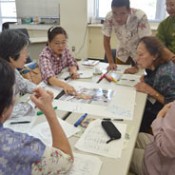
July 7, 2014 Ryukyu Shimpo
South American students of Okinawan descent took part in an extra-curricular course about Okinawa’s emigration history and South American cultures and lifestyles at the Okinawa Cultural Center in Okinawa City on July 3. About 40 elderly people from Peare Paradise Koju School, which specializes in lifelong learning, took part in the course. Through exchanges with the South American students, the elderly deepened their cross-cultural understanding.
Eight students from Bolivia, Argentina and Brazil, Peru and the United States took part. They held workshops for the elderly, using photographs of their countries and serving their local dishes.
Colin Foo from Hawaii introduced himself by using Uchinaguchi. He talked about the hog farms managed by his relatives.
Lusia Miyuki Teruya, who came from Brazil, described and showed photos of an annual Okinawan clan ceremony .
She pointed out one of her relatives in the photograph, who was holding red string for the ceremony. Lusia said that she realized the importance of connecting with her relatives through studying the history and ceremonies of Okinawa, where she has her roots.
Seventy-two-year-old Takeshi Takara said, “Interacting with South American Okinawan youth was a good experience for me. I enjoyed spending time with Uchinanchu from various countries.”
Hiroshi Oshiro, the administrative director of the Okinawa International Exchange & Human Resources Development Foundation which ran the course, said, “There are over 400,000 Okinawa descendants who come from various countries, in Okinawa and Japan. I would like Okinawan people to deepen cross-cultural understanding by exchanging culture with international students of Okinawan descent.”
(English translation by T&CT)
Go to Japanese
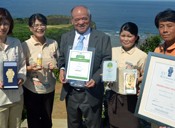
July 6, 2014 Ryukyu Shimpo
Uruma City based salt company Nuchi-masu has won the the Grand Gold Medal for five consecutive years at the 2014 Monde Selection, an international food and alcoholic beverage fair. The company also received the International High Quality Trophy, an award given to the company that won a grand gold medal or higher award for three or more years. The company’s tourist facility received the TripAdvisor Certificate of Excellence. TripAdvisor is a travel website providing information by word of mouth.
It was chosen among the top 12 in a list of the best factory tours in the country Trip Advisor Japan compiled.
Nuchi-masu Co. was founded in 1997. The company moved to Miyagijima Island in June 2007. It makes a type of salt containing a large amount of minerals using its own patent method of salt production called “Instant Mist-Dry Method.”
(English translation by T&CT)
Go to Japanese
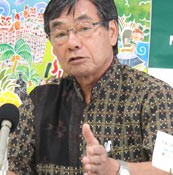
July 3, 2014 Ryukyu Shimpo
At a regular press conference on July 2, Nago Mayor Susumu Inamine criticized the Okinawa Defense Bureau for starting demolition of existing facilities in the U.S. military base Camp Schwab in Henoko, Nago, to build an alternative facility for U.S. Marine Corps Air Station Futenma. Inamine said, “The government aims to show that the relocation plan is progressing well.”
The Nago Mayor said that he had not received a detailed explanation from the Okinawa Defense Bureau. However, the government has now revealed information about the start of construction.
In the mayor’s view, the government is showing off that the relocation is progressing well after the Okinawa governor’s approval of the landfill application.
The mayor stressed that he would move to stop the main construction work for relocating the Futenma air station, using laws and regulations.
Referring to a temporary restricted sea area that the governments of Japan and the United States have set to prohibit fishermen from entering at all times, the mayor pointed out, “The water area is provided for the use of U.S. Military exercises. It lacks legitimacy to expand the restricted area for landfill.”
(English translation by T&CT)
Go to Japanese
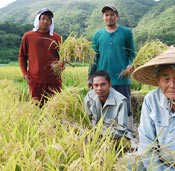
July 3, 2014 Hideaki Yoneda, correspondent of Ryukyu Shimpo
On June 29 in Tokashiki Village, rice harvesting began. Rice farmers have been busy gathering golden-colored paddy rice such as Milky Queen and Hitomebore. As farmers face a labor shortage due to the ageing population, three agriculture trainees from the Philippines have provided some relief to elderly farmers at the Toyama Farm. The farmers appreciated the trainees’ help.
Sacrificing their holiday for work, the trainees helped to handpick parts of rice that fall due to heavy rain, and they assisted with manual works before harvesting with a combine harvester.
Eighty-four-year-old Seichu Arakaki from Tokashiki Ward said that he was grateful for the help from Filipino trainees.
Seventy-six-year-old Seirin Toyama who hosts the trainees, remarked, “Thanks to the trainees, harvest is going well. Because of low temperature in March and April and the late end of rainy season, harvest is a couple of weeks behind the usual schedule. The quality is the same as usual.” The new rice will be consumed on the island.
(English translation by T&CT and Megumi Chibana)
Go to Japanese
July 1, 2014 Ryukyu SHimpo
Takamatsu Gushiken, the president of the Gamafuya, a volunteer group dedicated to the recovery of remains of the Battle of Okinawa, and the Okinawa Prefectural Assembly member Hiroshi Goya visited the Okinawa Prefectural Government Office on June 30.
They asked vice Governor Yoshihisa Kawakami not to cremate the remains of victims of the Battle of Okinawa preserved at temporary mortuary in Mabuni, Itoman.
The Gamafuya had asked the prefectural assembly to preserve the remains before cremation in order to extract DNA. Subsequently, the Okinawa Prefectural Government (OPG) halted the cremation in the last fiscal year.
However, the OPG decided to carry out the cremation this April because the mortuary has too many remains.
Gushiken said, “The Japanese and prefectural governments should consider expanding the mortuary because it is full of remains. Without the permission of bereaved families, they should not carry out the cremation.” He went on to say, “The cremation robs the bereaved family members of their right to get the remains.”
(English translation by T&CT)
Go to Japanese
July 1, 2014 Takumi Takimoto of Ryukyu Shimpo
Seven tuna fishing boats had their lines cut off one after another in waters near the main Island of Okinawa in May. On June 30, the Okinawa Prefecture Fishery Cooperative decided to make a claim to the U.S. government via the Navy’s Office of the Judge Advocate General to which a U.S. Navy vessel suspected to have been involved in the incidents belongs. The cooperative is collecting information on the damages and videotape evidence of the incidents.
As the cooperative and Okinawa Prefectural Government investigates the cause of the incidents, the Japanese government has asked them to file a claim to the U.S.military. The Japanese government determined that it is important to show its intent swiftly to the U.S. military in order to resolve the problem expediently and without complication.
After collecting enough data, the cooperative intends to make a claim to the U.S. Naval Forces Japan in Yokosuka City of Kanagawa prefecture and the U.S. Navy. Headquarters in Washington D.C.
Interviewed by the Ryukyu Shimpo, the head of the cooperative Shinko Kuniyoshi said, “We intend to report to the U.S. military on the number of damaged boats, and how and when the incidents occurred.”
The cooperative and prefectural government asked the Okinawa branch of the Ministry of Foreign Affairs of Japan to work on the cases. Kenichi Matsuda of the ministry said, “We want the owners of the damaged boats to file a claim to the Navy’s Office of the Judge Advocate General. After that, we intend to work on the cases.”
In the Committee on Foreign Affairs and Defense on June 12, the Minister for Foreign Affairs of Japan Fumio Kishida referred to the incidents. He said, “When these owners file a claim to the U.S.military, the Japanese government would like to provide indirect support for them as much as possible.”
Tsuyoshi Yamashiro of the prefectural government said on June 30, “The prefectural government will continue to support the related fisheries organizations to make sure the damages are compensated smoothly. We will also ask both the U.S. and Japanese governments to take preventative steps.”
Members of the Okinawan fishing industry suspect the US Navy Ocean Surveillance Ship Impeccable was involved in cutting the trawl lines of seven tuna fishing boats in waters near the main Island of Okinawa. The damaged boats belong to Okinawa fishing organizations.
The U.S. military did not refer to the Navy’s involvement in the incidents. They stated that if the owners think the U.S. Navy vessel damaged their boats, they can make a claim to the U.S. government via the Navy’s Office of the Judge Advocate General.
(English translation by T&CT)
Go to Japanese
26 June, 2014 Ryukyu Shimpo
The United States Marine Corps in Okinawa will move 15 KC-130 aerial refuelling tankers to the Marine Corps Air Station Iwakuni in Yamaguchi prefecture from Futenma Air Station. The U.S. military stated that they would continue to carry out training exercises of the aircraft in Okinawa even after the redeployment. Prime
Prime Minister Shinzo Abe explained at a meeting with the Okinawa prefectural government and Ginowan City government on June 24 the redeployment is part of the the plan to reduce the burden of military bases on Okinawa. However, he did not refer to the continuing training exercises.
The Marine Corps announced the first batch of the two aircraft would leave for Iwakuni on July 8. They explained, “Iwakuni will become the base for the squadrons to be moved from Okinawa, but the aircraft will continue to fly to the prefecture regularly.” The Marine Corps stated, “By using Futenma Air Station, Ie Island, and Kadena Air Base, the training airspace surrounding Okinawa, we will support operations, practice, and training.”
As for the reason behind continuing training on Okinawa, they stressed that they had an operational necessity as well as a duty to link with the ground forces on Okinawa. They suggested that it was absolutely imperative for the pilots and crew to carry out their training on the islands.
(English translation by T&CT and Lima Tokumori)
Go to Japanese
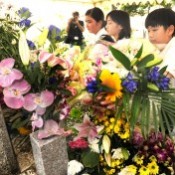
June 30, 2014 Ryukyu Shimpo
Fifty-five years have passed since June 30, 1959, when a U.S. F-100 fighter from Kadena Air Base crashed into Miyamori Elementary School in Ishikawa City, currently Uruma City. The 55th anniversary memorial ceremony was held on June 30 at the school. Participants paid their respects to the 18 victims.
About 90 bereaved family members, former pupils who attended the school at the time of the crash, and local residents attended.
Mitsuteru Toyohama, the head of the Ishikawa and Miyamori 630 Association, said, “The survivors of the Battle of Okinawa were killed in the accident. Their children were killed too.” He went on to say, “Okinawa has faced horrible histories since the war. We will never forget the accident.”
The participants offered a thousand paper cranes and floral tributes to the Nakayoshi-Jizo or Good Friend-Jizo (the protector of deceased children) statue. The statue has the names of the 18 victims, including locals and pupils inscribed on it. At 10:40 a.m., the time the military jet crashed, the participants offered silent prayers.
(English translation by T&CT)
Go to Japanese
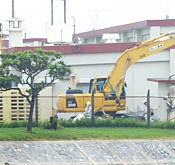
July 2, 2014 Ryukyu Shimpo
On July 1, the Okinawa Defense Bureau began bulldozing buildings within Camp Schwab in Henoko, Nago, to construct an alternative facility for the U.S. Marine Corps Air Station Futenma. Prior to demolition work commencing, the defense bureau submitted a notification form with the Okinawa Government Office based on the Okinawa Prefecture Environmental Impact Assessment Ordinance on June 30. According to the notification, the construction includes part of the planned airfield and related facilities. The defense bureau has carried out environmental impact assessment research in the sea area and design work for the landfill. However, this is the first time there has been construction work at the planned site.
The defense bureau will submit a notification form with the Okinawa Prefectural Government to start construction in the sea area. It plans to carry out undersea drilling in late July prior to the reclamation taking place. A replacement for the Futenma airfield which is due to close, the runway is a total of about 205 hectares, including a land area of about 45 hectares and a reclamation area of about 160 hectares.
The defense bureau had already begun removing some barracks in Camp Schwab. However, now they have begun demolishing the barracks, medical office buildings and warehouses in an area that is a part of the V-shaped runway planned by the governments of Japan and the United States.
It was agreed at a meeting of the Japan-U.S. Joint Committee on June 20 that they would start the demolition operation in order to secure a work yard for temporary storage for revetment blocks and other materials.
This will be a large-scale construction, including removing three buildings, two barracks and one warehouse in an area of about 2,500 square meters within the planned site of V-shaped runway. The construction period for the work yard will be until the end of January next year. It is costing about 93 million yen for the demolition work. The defense bureau plans to start reclamation after it has taken down the old buildings and other facilities to secure a work yard. The completion of all construction projects for an alternative facility for the Futenma base is scheduled for October 31, 2019.
On July 1, Ryukyu Shimpo reporters confirmed that demolition workers were taking down the old facilities within Camp Schwab. A dozen vessels, including guard boats and research vessels employed by the defense bureau and Japan Coast Guard’s boats, patrolled the sea near the planned reclamation site. Residents also took boats out to sea to protest against the construction, but there was no confrontation.
(English translation by T&CT)
Go to Japanese
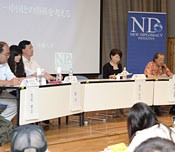
June 30, 2014 Ryukyu Shimpo
Tokyo based think tank the New Diplomacy Initiative and Okinawa University Regional Research Institute held a symposium on the theme of the relationship between Okinawa, China and Japan at Okinawa University in Naha on June 29.
Nanjing University professor Liu Cheng, a specialist in irenology, the study of peace, delivered the keynote speech. He referred to Okinawa, which has a long historical relationship with China and the disputed Senkaku/Diaoyu Islands. Cheng said, “I would like Okinawa to serve as a bridge between Japan and China. I do not want a war to start in the prefecture.”
He claimed diplomatic policies with a hostile view of other countries and regions, are out of date in global society. Cheng stressed that it is important for Japan and China to promote collaboration and dialogue.
He outlined the Chinese government’s claim that the Diaoyu Islands are inherently territories of China.
Cheng was born and raised in Nanjing. This is the first time that he has visited Okinawa. He highlighted similarities between Okinawa, where many civilians were killed in the Battle of Okinawa, and Nanjin where the Nanjing Massacre occurred during the Sino-Japanese War. Cheng claimed, “We need to avoid wars that take many people’s lives.”
Referring to China’s rapid economic growth, he said, “China seeks a peaceful environment to keep economically growing.”
Director of the think tank, Sayo Saruta reported on Nago Mayor Susume Inamine’s visit to the United States. Saruta arranged the meeting between US government officials and Inamine, who visited the United States to convey his opposition to Henoko relocation .
Moriteru Arasaki, professor emeritus at Okinawa University, Masaaki Gabe, a professor at the University of the Ryukyus and Yasushi Ikeo, adjunct instructor at Ritsumeikan University took part as panelists.
(English translation by T&CT)
Go to Japanese








 Webcam(Kokusai Street)
Webcam(Kokusai Street)


